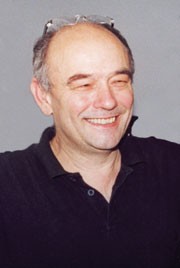Reinhart Heinrich (1946–2006) (original) (raw)
Pioneer in systems biology.
In biology, mathematical systems analysis was until recently nearly invisible in the dazzling light of twentieth-century discoveries. But it has emerged from the shadows in the field of systems biology, a subject buoyed by immense data sets, conveyed by heavy computing power, and addressing seemingly incomprehensible forms of complexity. If systems biology has heroes, one of them is Reinhart Heinrich, a former professor at the Humboldt University in Berlin, who died on 23 October, aged 60. His most famous accomplishment was metabolic control theory, published in 1974 with Tom Rapoport and formulated independently by Henrik Kacser and James A. Burns in Edinburgh, UK.
From the 1930s to the 1960s, biochemists were busy describing metabolic pathways, just as molecular biologists today are feverishly trying to inventory the cell's gene-transcription and signalling circuits. The basic kinetic features of the enzymes in the major pathways were studied in great detail and with exceeding care. It seemed self-evident that, knowing the properties of each element, the behaviour of a pathway in vivo could simply be understood as the sum of its enzymes.

One assertion, drilled into the head of every biochemist, was the concept of the rate-limiting step. In this view, the flux through a pathway was determined by the slowest reaction, in the way a bucket brigade fighting a fire would be limited by the speed of the slowest member. Yet this concept, as shown by the metabolic control theory, was theoretically flawed, practically incomplete and often wrong, as many efforts to genetically engineer enzymes by changing 'rate-limiting steps' would ultimately show.
Metabolic control theory introduced the concept of control coefficients — dimensionless quantities indicating how the flux of a pathway depended on a given step. Only a pathway where every control coefficient except one was zero would have a rate-limiting step, since the flux of that pathway would depend only on that step. Several pathways in fact had rate-limiting steps, but that often reflected the structure of the pathway, and could not simply be deduced from the maximum rates of the individual enzymes, their Michaelis constants or their displacement from equilibrium. Many pathways were instead networks, with the fluxes distributed in a self-governing way among its various branches.
Heinrich went on to apply this theory to the real case of glycolysis in red blood cells, where he showed that the flux of the reaction was shared by several enzymes. Much later, he extended his ideas to signal-transduction pathways, introducing control coefficients to dynamic processes. Sticking to real examples, such as the Wnt signalling and MAP kinase pathways, he again demonstrated that new properties and constraints emerge when the individual steps are combined into a complete pathway.
Heinrich also pointed the way to considerations of optimality theory and evolution that will confront systems biology for the next century. The question of evolution lies just beneath any effort to understand biology. Yet in most cases, physiological function and evolutionary change are considered distinct and are investigated by different people. Heinrich's work illustrated how systems biology might develop, where the central question will be not only how a system works, but why it has the specific design it has. In examining optimization for metabolic pathways, he found that there is no unique solution for the individual rate constants and affinities, but many solutions that are each optimized with respect to certain conditions. By considering the criteria for optimization, such as pathway flux or minimization of enzyme concentration, he nevertheless found general tendencies, such as a match between the Michaelis constant and substrate concentration. Evolutionary optimization is becoming a central feature in systems biology.
Some of the wrenching political developments of the twentieth century framed Heinrich's life, and it is a tribute to the collegiality of science that his reputation and influence were able to transcend such considerations. He was born in Dresden, but spent his early years in Kuibishev, Russia. His father, a professor of applied mathematics, belonged to the group of scientists in East Germany who, after the Second World War, were rounded up by the Russians to help build their aviation industry.
The family returned to East Germany in the early 1950s, and Heinrich studied solid-state physics in Dresden. But after his PhD he became interested in applying physics to biology, and moved to East Berlin to join the group of Samuel Rapoport — a family connection that later continued when he worked with the son, Tom. Rapoport senior was a biochemist who himself was a refugee (in this case from anti-communist hysteria in the United States). In East Berlin, travel and outside communication were severely restricted, but Heinrich partly coped with the isolation by organizing meetings in East Germany. When the Berlin Wall fell, his fame began to spread more rapidly, increasing as systems biology has taken off as an organized discipline over the past few years.
Reinhart Heinrich's character is revealed both in his originality in seeking rational explanations in biology and in his approach to life in general. He published a prizewinning philosophical novel (Jenseits von Babel [_Beyond Babel_]) and a book of poems. He played the violin and was well versed in history and literature; he also had an amazing ability to remember what he had done on every day of his life. His humour and charm were contagious. He trained a whole generation of students, becoming the father of the Berlin school of theoretical biophysics, and led us to the edge of a new domain of knowledge. Reinhart died too young. But he was fortunate enough to have glimpsed the future outlines and promise of systems biology, a field he himself was instrumental in founding.